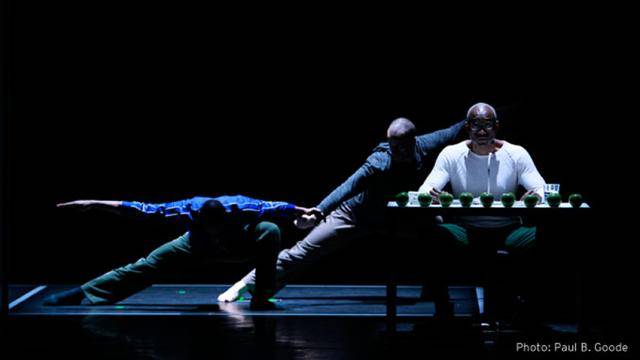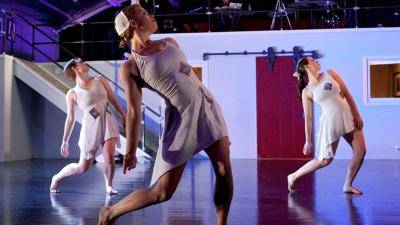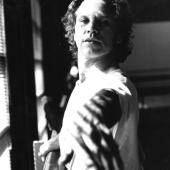Watching Bill T. Jones and his company performing “Story/Time” at the Long Beach Carpenter Center I was reminded not how much modern dance has changed but how it still looks like old experiments by Cunningham and the Judson era dance pioneers. That sort of dance is a modus operandi that has been taken up repeatedly by contemporary companies everywhere who limn the possibilities of text driven movement, DJ’s remixing music, and mixed media, packaging it all in a continuous hour or so of theater. This work, like Cunningham’s “Roaratorio” presented at Disney Hall in 2012 during the Cunningham Legacy Tour, felt like an original experimental studio performance redesigned for the formality and more exacting domain of a real theater. It had plenty of visual appeal and an edgy downtown look.
These dancers have special skills, they are virtuosos of a different brand of dance...
Jones’s piece covers many stories, his mostly, each about a minute in length. They are poetic vignettes of family, race, and sex, the same themes that have been the engine for many of his Jones’s narrative works. In this instance he presides over the stories like a master of ceremonies seated center stage and reading from behind a small modern desk. Behind him, floating in the darkness is a digital clock ticking off the minutes and seconds like a sporting event. Each story is about a minute with the entire piece lasting exactly 70 minutes. His dancers, nine of them, spill across the stage in front, beside, and behind him. Jones in other instances has put dance to music frequently with clear connections but in “Story/Time” the narrative connections remain distant and sometimes annoyingly ambiguous. It doesn’t feel like a performance in the usual sense. Somehow “Story/Time” reduces the audience to voyeurs. The dancers are involved in a partially improvised odyssey of some sort and it’s clear that it is their odyssey and not ours.
Much of the dancing looks terrific, especially the unison sections in which groups race across the stage and are up and down on the floor multiple times during thirty seconds of dancing. These dancers have special skills, they are virtuosos of a different brand of dance, one that comes out of improvisation, theater, and from time to time, stand-alone dance of the sort we are used to. They are a mixed crew of nine, each with individual attractiveness. Liz Prince is the costume designer. She has dressed them in something that looks like mix and match dance class attire or workout gear. They eventually change into something more costume like--bright colored pants and dresses--and then back.
Accompanying Jones and his stories are clips of sound, actual playing, songs, and voices, all woven together by Ted Coffey. Some of them are quiet comforting sounds, tocks and gurgles, but others boom and grate, drowning out Jones as reads. The composer and computer wizard behind sound score is Ted Coffey. You can watch him throughout the performance because he has his laptops and monitors set up at the edge of the pit in full view of the audience. It feels a little like watching the Wizard of Oz with the curtain drawn back. But both Jones and Coffey eventually become distractions. The clock disappears part way into the performance. But Jones and Coffey remain long after our genuine curiosity about them has subsided. Jones and the dancers do interact but the interaction is only occasionally significant. Some of it, like the stagey business with the apples that ring the desk feels overly contrived.
The stage is divided into multiple rectangles that can be individually highlighted by a grid of focused lights. I suppose it was a reflection of the cellular nature of the stories themselves, but maybe not. As with much of Jones’s work, the themes are not always readily explainable. Much is left up for grabs. In the end, “Story/Time” wanders more than it heads in any particular direction. It felt freshest at the outset. I would have liked to have seen it finish without the clock returning. Somehow it felt like giving away some small but important piece of the ending.



